Religion
Religion has always been an important cultural part of Tennessee life. From the first settlers onward, religious organizations have had a great social and moral impact on the state.
Though church-going Tennesseans were attracted to the technology of the time, they were often dismayed by popular trends in music, fashion, and manners.
Sam Jones was one of those people who was concerned about the trends. A Methodist minister, Jones preached revivals and sermons throughout Tennessee in the 1880s. He conducted large revivals under tents which could hold more people than most churches.
His sermons warned about the consequences of sins such as drinking alcohol, gambling, and even attending the theatre. He preached to thousands for three weeks in Nashville in 1885.
Jones' sermons touched Captain Tom Ryman, who owned gambling boats in the state. After having a spiritual awakening, Ryman ended his gambling businesses and tossed the liquor on his boats overboard.
Ryman built the Union Gospel Tabernacle in Nashville for $100,000 to further the preaching of the Gospel in the city. It was later named Ryman Auditorium after his death, and served many years as the home of the Grand Ole Opry.
There was a revival in religious beliefs in the South during the 1880s. Preachers taught that it wasn’t enough to go to church. Christians had to fight sin wherever it was. One of the sins they fought was drinking alcohol. They believed that drinking caused violence and poverty. Many church members started working for Temperance Movements.
Some Christians in Tennessee also believed in social gospel, a philosophy which mandated that as Christians they had to help people in need and work to change society as a whole. For example, Mark A. Matthews, a Presbyterian pastor in Jackson, Tennessee, helped start a night school, a library, a hospital, a local YMCA, a Humane Society, as well as care for the poor.
Other Christians who were concerned about religious trends called on the state to pass laws to preserve Sundays as a day of worship and religious services. They wanted to ban the running of trains and other work on a day that they felt was for God’s work. These were called Blue Laws.
While they were not very successful in having Blue Laws passed, keeping a traditional Sunday of no work was generally followed in Tennessee and other southern states. It is the reason that Sunday is seen as a day of rest even today, although many more businesses are open on the day than in the past.
With the churches’ activities in Blue Laws and prohibition, they became more involved in state politics than ever before. Churches held meetings and participated in planning sessions on moral and religious issues. This trend continued into the 1900s. In 1928, ministers urged their members to vote against Al Smith for president due to his anti-prohibition beliefs.
Churches did use more modern methods to persuade people to come to church. They advertised on billboards, had lighted signs in front of the church buildings, and published weekly church papers. These and other methods evidently worked. According to a religious census in 1906, church membership had increased by 150 percent.
An evangelistic trend was also strong in the state. Several new Christian denominations such as the Church of the Nazarene were started in Tennessee. The Church of God emerged from the region of East Tennessee and western North Carolina. The church followed such Pentecostal practices, as being born again and speaking in tongues. Like many other emerging denominations, they believed in abstinence from alcohol and tobacco.
African Americans in Tennessee also participated in the religious revival, organizing the Church of God in Christ in Memphis in 1907. This denomination is also in the Pentecostal tradition, emphasizing prophetic utterances and the gifts of the Holy Spirit.
In 1880 a group of British and Americans founded a colony based on utopian ideas. They envisioned people, both black and white, working together in a model community. The village, called Rugby, was located in Morgan County and grew to about 450 residents. Eventually people became disillusioned and moved away. The community never met the expectations of its founders. For more information about Rugby, click here.
Picture Credits:
- Photograph of a Rugby Colony Picnic. This photo was taken in Rugby, Tennessee in the 1880s. University of Tennessee, Special Collections.
- Photograph of Reverend Sam P. Jones. This photo was taken around 1889, when Jones held a revival in Durham, North Carolina. University of North Carolina.
- Photograph showing the inside of the General Assembly Auditorium. This photo was taken in Cleveland, Tennessee. It shows A. J. Tomlinson, a leader of the church, and Mrs. Lillian Kinsey, the first matron of the church’s orphanage. Hal Dixon Jr. Pentecostal Research Center, Lee University.
- Photograph entitled, “Cades Cove baptising.” This photo was taken on August 7, 1920, probably in Blount County, Tennessee. It shows a group of boys and girls standing in the water waiting to be baptized. A large group of adults are standing behind them on land. Blount County Public Library.
- Photograph of Reverend Isaac S. Anderson and his horse, “Old Mack.” This photo was taken in 1907 in the Appalachian region. It also shows Anderson with three local women. Reverend Anderson was a circuit preacher who traveled from Rose Hill, Virginia to the Cumberland Gap region of Tennessee in order to hold ministerial services. Lincoln Memorial University.
- Photograph entitled “Mrs. McNeil’s Sunday School Class.” This photo was taken in 1930 in Johnson City, Tennessee. It shows a group of small children and three women posing for a portrait outside of the First Congregational Church. A sign that reads, “We feed babies,” can also be seen. East Tennessee State University.
- Photograph of a river baptism. This photo was taken in 1920 in Clarksville, Tennessee. It shows a large group watching a person being baptized by a preacher. Austin Peay State University.
- Photograph showing the inside of the Sharps Station Methodist Episcopal Church. This photo was taken by Lewis Hine near Loyston, Tennessee. It shows a Reverend Lovelace and his small church congregation. Children from a nearby orphanage are at the altar. Tennessee State Museum Collection, 89.12.3.
Confronting the Modern Era >> Life in Tennessee >> How They Lived >> Religion
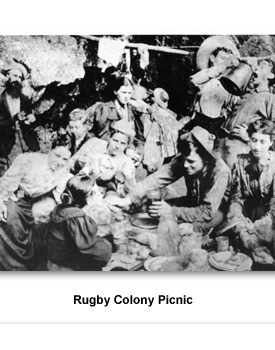
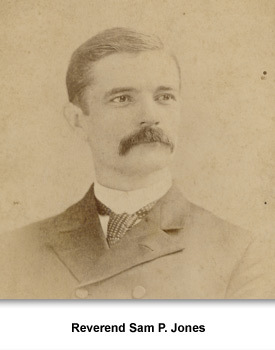
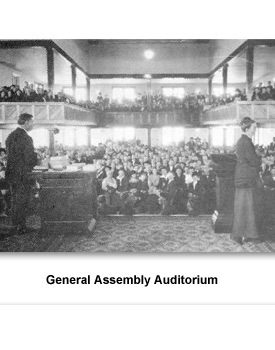
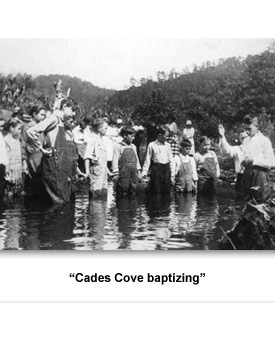
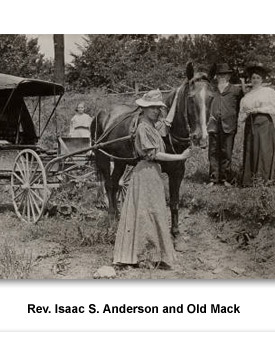
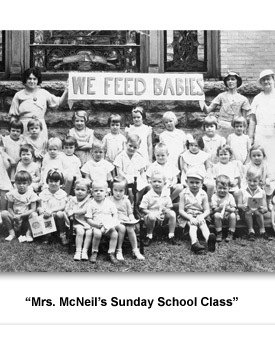
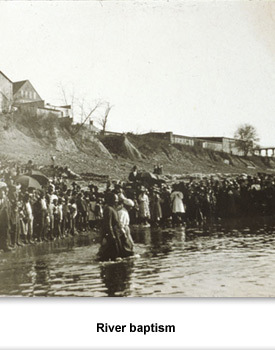
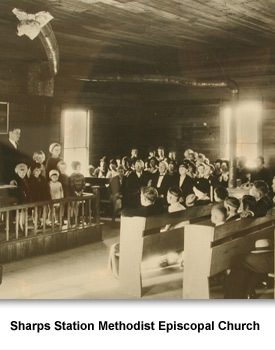
 Sponsored by: National Endowment for the Humanities
Sponsored by: National Endowment for the Humanities